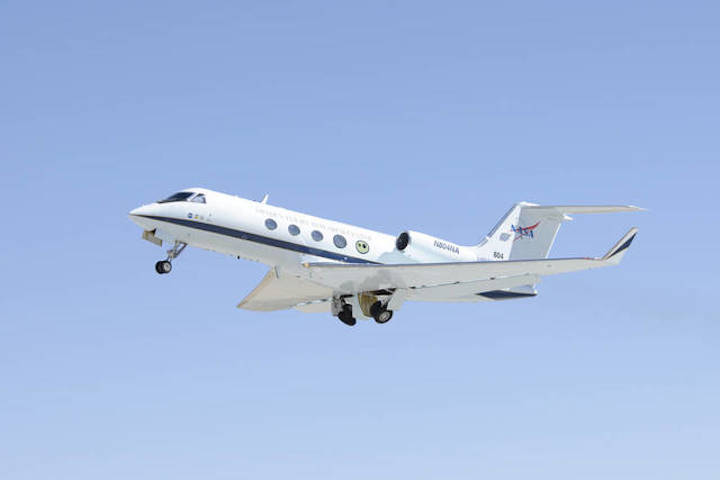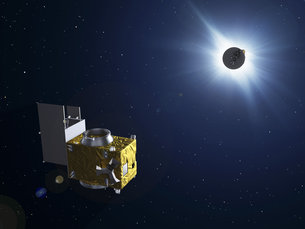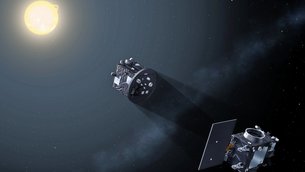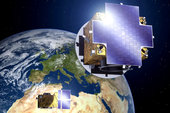Multiple organizations are live-streaming the total solar eclipse in incredible and unique ways — take a look!
A solar eclipse ought to be seen in person — whether it’s awe-inspiring totality or a captivating partially covered Sun. So, if at all possible, go outside and take a look, making sure to use approved solar viewers or a homemade pinhole projector during the partial phases of the eclipse.
But life happens. Maybe you’re stuck in the office, were unlucky with the weather, or you’re just in the wrong part of the world for this particular event. Don’t worry, we’ve got you covered.
Multiple organizations are live-streaming the eclipse in incredible and unique ways. (Not to mention the 90-minute movies that the Megamovie Project and Citizen CATE organizations are creating, which will be available shortly after the eclipse is done.)
Browse the following list for live-stream eclipse webcasts:
- NASA: 12 p.m. to 4 p.m. EDT, will include live coverage from 12 locations, featuring live views of the eclipse as well as eclipse activities taking place across the country. There are multiple ways to watch, including NASA's website, Facebook live, and YouTube.
- Exploratorium: This science museum in San Francisco will be begin its eclipse webcast at 12 p.m. EDT, featuring telescopes based in Oregon and Wyoming. At 12:15 p.m. EDT, listen in to experience the Kronos Quartet's sonification of the solar eclipse. You can also watch using Exploratorium's free Androidand iPhone apps.
- CNN: CNN is teaming up with Volvo to present Eclipse of the Century, which will present the eclipse from viewing locations across the path of totality with live, 360° coverage.
- Montana State University: Watch the eclipse from an entirely different perspective — 55 high-altitude balloon teams are teaming up with NASA to provide coverage of the solar eclipse from the stratosphere. Learn more about how and why they're doing it — and watch the live webcast on August 21st — from the Eclipse Across America website.
- Slooh: Beginning at 11:30 a.m. EDT, Slooh will provide live coverage of the total solar eclipse from Stanley, Idaho, with additional telescope feeds all along the path of totality.
- TimeandDate.com: Watch the eclipse's progress starting at 11:30 a.m. EDT, with live footage from multiple locations and real-time updates on the current location of the Moon's shadow.
Quelle: Sky&Telescope
---
Update: 20.08.2017
.
Looking directly at the sun is unsafe except during the brief total phase of a solar eclipse (“totality”), when the moon entirely blocks the sun’s bright face, which will happen only within the narrow path of totality (https://go.nasa.gov/2pC0lhe(link is external)).
The only safe way to look directly at the uneclipsed or partially eclipsed sun is through special-purpose solar filters, such as “eclipse glasses” (example shown at left) or hand-held solar viewers. Homemade filters or ordinary sunglasses, even very dark ones, are not safe for looking at the sun; they transmit thousands of times too much sunlight. Refer to the American Astronomical Society (AAS) Reputable Vendors of Solar Filters & Viewers(link is external) page for a list of manufacturers and authorized dealers of eclipse glasses and handheld solar viewers verified to be compliant with the ISO 12312-2 international safety standard for such products.
- Always inspect your solar filter before use; if scratched or damaged, discard it. Read and follow any instructions printed on or packaged with the filter.
- Always supervise children using solar filters.
- Stand still and cover your eyes with your eclipse glasses or solar viewer before looking up at the bright sun. After looking at the sun, turn away and remove your filter — do not remove it while looking at the sun.
- Do not look at the uneclipsed or partially eclipsed sun through an unfiltered camera, telescope, binoculars, or other optical device.
- Similarly, do not look at the sun through a camera, a telescope, binoculars, or any other optical device while using your eclipse glasses or hand-held solar viewer — the concentrated solar rays will damage the filter and enter your eye(s), causing serious injury.
- Seek expert advice from an astronomer before using a solar filter with a camera, a telescope, binoculars, or any other optical device. Note that solar filters must be attached to the front of any telescope, binoculars, camera lens, or other optics.
-
 If you are within the path of totality (https://go.nasa.gov/2pC0lhe(link is external)), remove your solar filter only when the moon completely covers the sun’s bright face and it suddenly gets quite dark. Experience totality, then, as soon as the bright sun begins to reappear, replace your solar viewer to look at the remaining partial phases.
If you are within the path of totality (https://go.nasa.gov/2pC0lhe(link is external)), remove your solar filter only when the moon completely covers the sun’s bright face and it suddenly gets quite dark. Experience totality, then, as soon as the bright sun begins to reappear, replace your solar viewer to look at the remaining partial phases. -
Outside the path of totality, you must always use a safe solar filter to view the sun directly.
-
If you normally wear eyeglasses, keep them on. Put your eclipse glasses on over them, or hold your handheld viewer in front of them.
Note: If your eclipse glasses or viewers are compliant with the ISO 12312-2 safety standard, you may look at the uneclipsed or partially eclipsed Sun through them for as long as you wish. Furthermore, if the filters aren't scratched, punctured, or torn, you may reuse them indefinitely. Some glasses/viewers are printed with warnings stating that you shouldn't look through them for more than 3 minutes at a time and that you should discard them if they are more than 3 years old. Such warnings are outdated and do not apply to eclipse viewers compliant with the ISO 12312-2 standard adopted in 2015. To make sure you get (or got) your eclipse glasses/viewers from a supplier of ISO-compliant products, see the American Astronomical Society (AAS) Reputable Vendors of Solar Filters & Viewers(link is external) page.
An alternative method for safe viewing of the partially eclipsed sun is pinhole projection(link is external). For example, cross the outstretched, slightly open fingers of one hand over the outstretched, slightly open fingers of the other, creating a waffle pattern. With your back to the sun, look at your hands’ shadow on the ground. The little spaces between your fingers will project a grid of small images on the ground, showing the sun as a crescent during the partial phases of the eclipse. Or just look at the shadow of a leafy tree during the partial eclipse; you'll see the ground dappled with crescent Suns projected by the tiny spaces between the leaves.
A solar eclipse is one of nature’s grandest spectacles. By following these simple rules, you can safely enjoy the view and be rewarded with memories to last a lifetime. More information:
This document does not constitute medical advice. Readers with questions should contact a qualified eye-care professional.
Additional Safety Information
An eclipse is a rare and striking phenomenon you won't want to miss, but you must carefully follow safety procedures. Don't let the requisite warnings scare you away from witnessing this singular spectacle! You can experience the eclipse safely, but it is vital that you protect your eyes at all times with the proper solar filters. No matter what recommended technique you use, do not stare continuously at the sun. Take breaks and give your eyes a rest! Do not use sunglasses: they don't offer your eyes sufficient protection. The only acceptable glasses are safe viewers designed for looking at the sun and solar eclipses. One excellent resource on how to determine if your viewers are safe can be found here: https://eclipse.aas.org/eye-safety/iso-certification(link is external)
Viewing with Protection -- Experts suggests that one widely available filter for safe solar viewing is welders glass of sufficiently high number. The only ones that are safe for direct viewing of the Sun with your eyes are those of Shade 12 or higher. These are much darker than the filters used for most kinds of welding. If you have an old welder's helmet around the house and are thinking of using it to view the Sun, make sure you know the filter's shade number. If it's less than 12 (and it probably is), don't even think about using it to look at the Sun. Many people find the Sun too bright even in a Shade 12 filter, and some find the Sun too dim in a Shade 14 filter — but Shade 13 filters are uncommon and can be hard to find. The AAS Reputable Vendors of Solar Filters & Viewers page(link is external) doesn't list any suppliers of welder's filters, only suppliers of special-purpose filters made for viewing the Sun.To find out more about eyewear and handheld viewers go to https://eclipse.aas.org/eye-safety/eyewear-viewers(link is external).
Telescopes with Solar Filters – Eclipses are best viewed directly when magnified, which means a telescope with a solar filter or solar telescopes. These will give you a magnified view that will clearly show the progress of an eclipse. Never look through a telescope without a solar filter on the large end of the scope. And never use small solar filters that attach to the eyepiece (as found in some older, cheaper telescopes.) https://eclipse.aas.org/eye-safety/optics-filters(link is external)
Pinhole and Related Projection Methods(link is external) -- Pinhole projectors and other projection techniques are a safe, indirect viewing technique for observing an image of the sun. These provide a popular way for viewing solar eclipses. One viewing technique is to project an image of the sun onto a white surface with a projecting telescope. This is explained further here: http://www.astrosociety.org/education/publications/tnl/05/stars2.html(link is external)
The Exploratorium demonstrates how to view a planet in transit or an eclipse safely by projecting the image with binoculars:http://www.exploratorium.edu/transit/how.html(link is external). There are commercially available projection telescopes as well.
Besides eye protection during solar eclipse viewing, one needs to pay attention to their personal needs and surrounding. Below are some additional safety tips for eclipse observers before, during and after the August 21, 2017 solar eclipse.
Graphics-Only Solar Eclipse Safety Flyer
Car Safety
Planning to Drive the Eclipse(link is external)
https://www.ready.gov/car(link is external)
Camping Health and Safety
https://www.cdc.gov/family/camping/(link is external)
http://www.recreation.gov/recFacilityActivitiesHomeAction.do?goto=camping.htm&activities=9(link is external)
Heat and Children in Cars
http://www.safercar.gov/parents/InandAroundtheCar/heatstroke.htm(link is external)
http://www.safercar.gov/parents/InandAroundtheCar/heat-involved.html(link is external)
Federal Emergency Management Agency(link is external) – Are You Ready
Food and Water Safety(link is external)
Hazards to Outdoors Workers(link is external)
Heat and Hydration(link is external)
Hiking Safety(link is external)
Large Crowds Safety(link is external)
Personal Safety(link is external) – At Home, On the Street, While Traveling
Sun Safety:(link is external) Save Your Skin
Quelle: NASA
---
Update: 21.08.2017
.
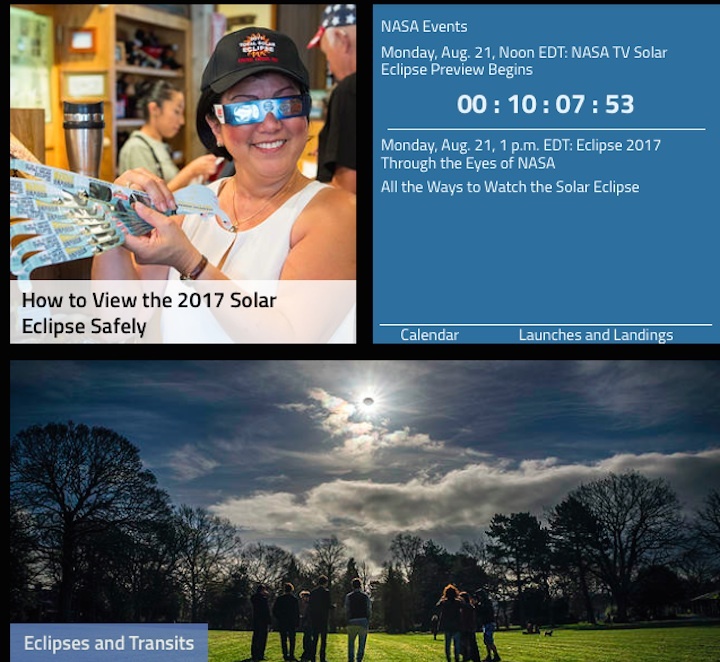
Quelle: NASA
+++
NASA SoFi-LIVE-Fotos:
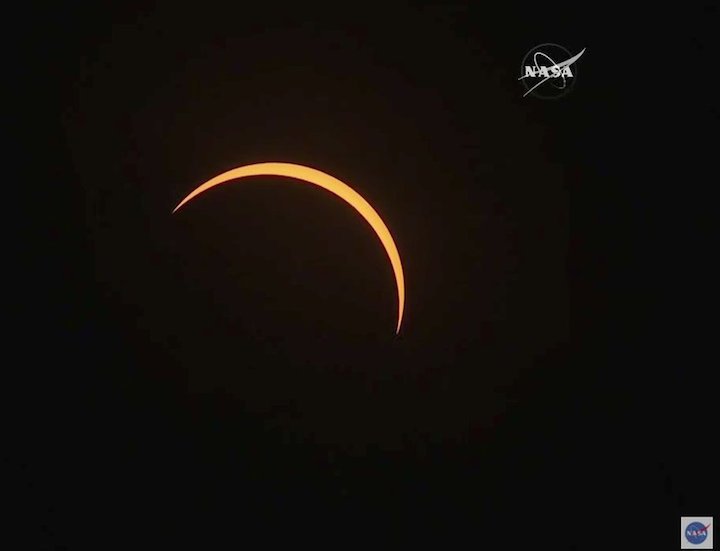


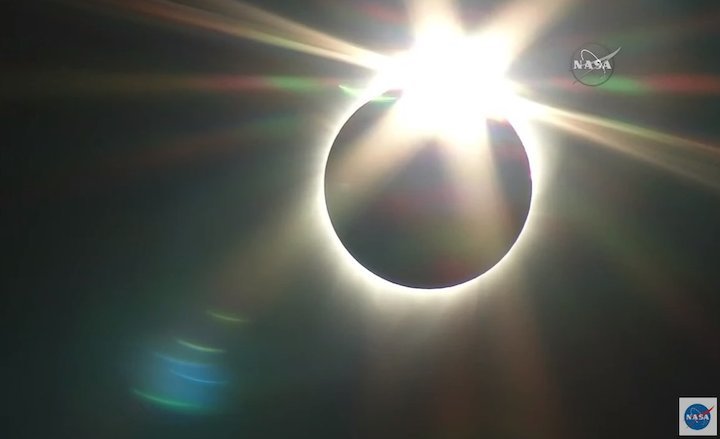
Quelle: NASA
+++
Update: 22.08.2017 SoFi im Rückblick:
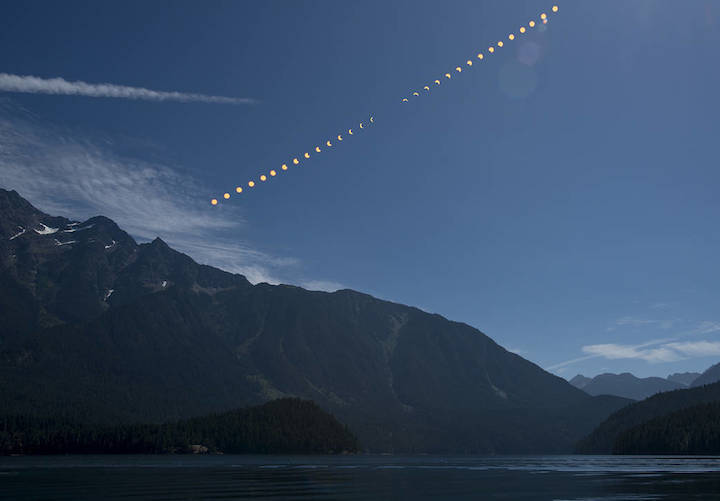
This composite image shows the progression of a partial solar eclipse over Ross Lake, in Northern Cascades National Park, Washington on Monday, Aug. 21, 2017. A total solar eclipse swept across a narrow portion of the contiguous United States from Lincoln Beach, Oregon to Charleston, South Carolina. A partial solar eclipse was visible across the entire North American continent along with parts of South America, Africa, and Europe.
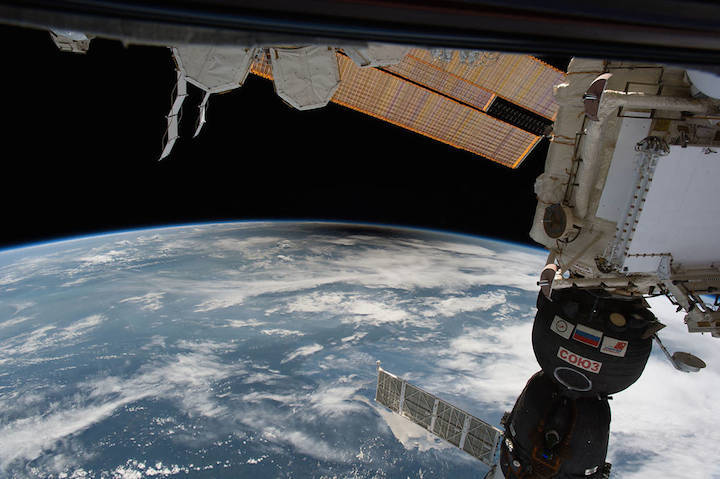
iss052e056225 (Aug. 21, 2017) --- As millions of people across the United States experienced a total eclipse as the umbra, or moon’s shadow passed over them, only six people witnessed the umbra from space. Viewing the eclipse from orbit were NASA’s Randy Bresnik, Jack Fischer and Peggy Whitson, ESA (European Space Agency’s) Paolo Nespoli, and Roscosmos’ Commander Fyodor Yurchikhin and Sergey Ryazanskiy. The space station crossed the path of the eclipse three times as it orbited above the continental United States at an altitude of 250 miles.
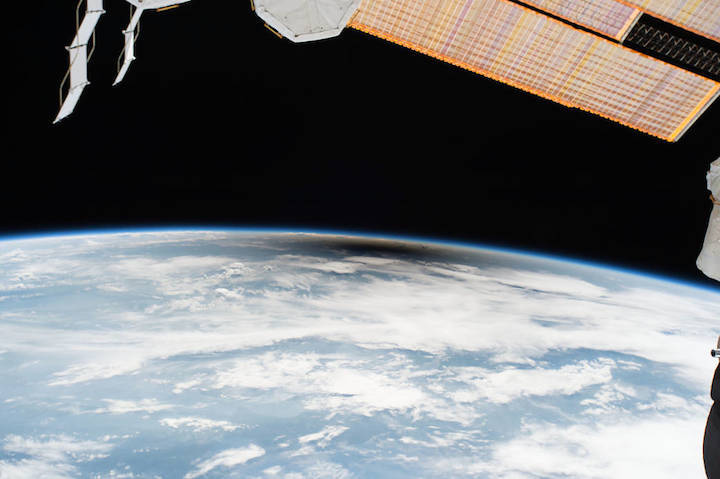
iss052e056222 (Aug. 21, 2017) --- As millions of people across the United States experienced a total eclipse as the umbra, or moon’s shadow passed over them, only six people witnessed the umbra from space. Viewing the eclipse from orbit were NASA’s Randy Bresnik, Jack Fischer and Peggy Whitson, ESA (European Space Agency’s) Paolo Nespoli, and Roscosmos’ Commander Fyodor Yurchikhin and Sergey Ryazanskiy. The space station crossed the path of the eclipse three times as it orbited above the continental United States at an altitude of 250 miles.
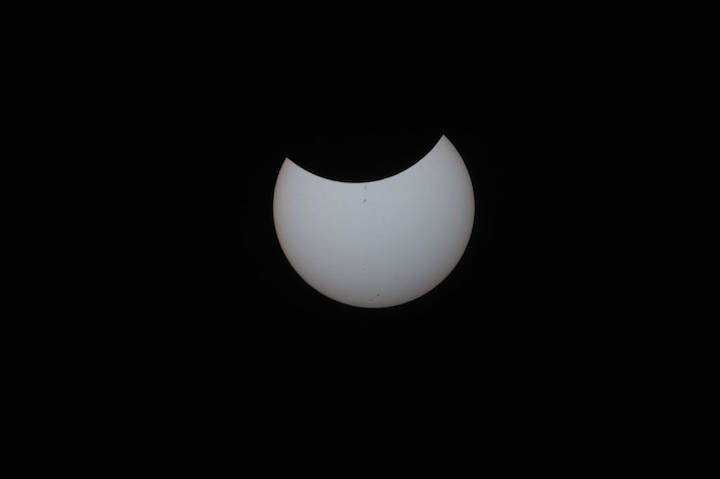
iss052e055885 (Aug. 21, 2017) --- Aboard the International Space Station, NASA Flight Engineer Randy Bresnik took still images of the eclipse as seen from the unique vantage of the Expedition 52 crew. Witnessing the eclipse from orbit with Bresnik were NASA’s Jack Fischer and Peggy Whitson, ESA (European Space Agency’s) Paolo Nespoli, and Roscosmos’ Commander Fyodor Yurchikhin and Sergey Ryazanskiy. The space station crossed the path of the eclipse three times as it orbited above the continental United States at an altitude of 250 miles.
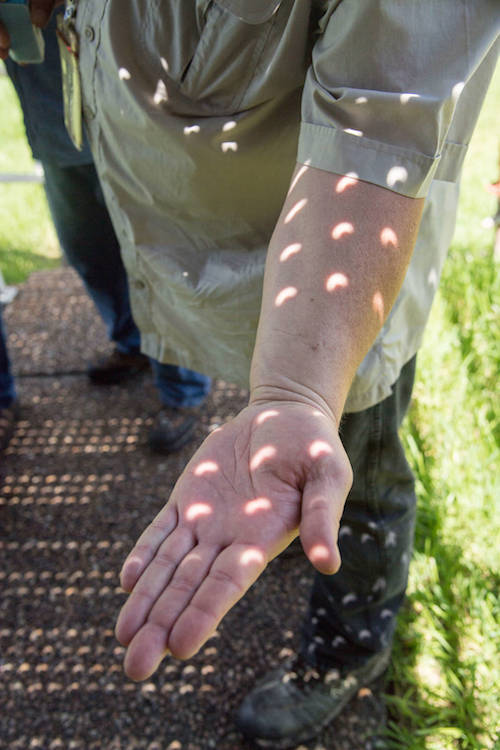
jsc2017e110783 (Aug. 21, 2017) --- Employees at NASA’s Johnson Space Center in Houston joined the rest of the country in experiencing the 2017 eclipse on Aug. 21, 2017. Many used protective eclipse glasses, and others made use of manufactured or pin-hole cameras of opportunity to view the eclipse. In Houston, the partial eclipse duration was 2 hours, 59 minutes, reaching its maximum level of 70 percent at 1:16 p.m. CDT. Some members of the team supporting the International Space Station in the Christopher C. Kraft Mission Control Center took advantage of a break in their duties to step outside the windowless building to witness what their colleagues in orbit also saw and documented with a variety of cameras.
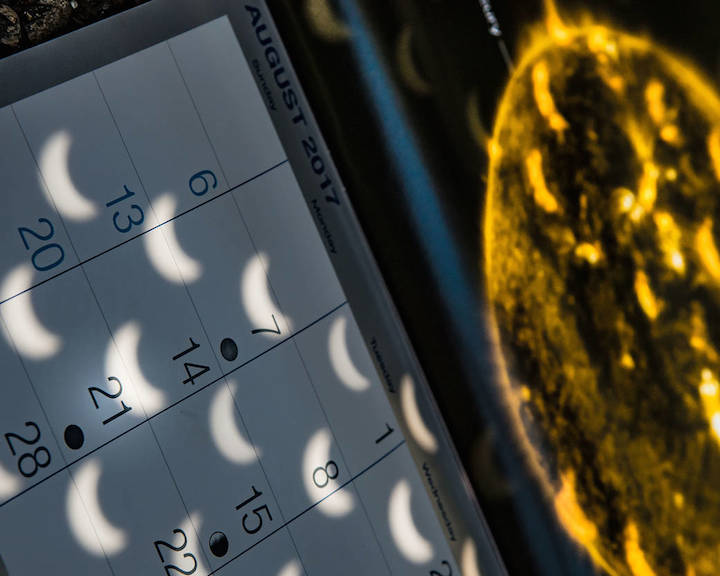
Experiencing Totality: Eclipse Stories From Sky & Telescope

Third contact, as seen in Rexburg, Idaho.
Gert Cazemier
To experience a total solar eclipse is to experience the sublime. It is to encounter something that is so awe-inspiring, so earth-shattering, that you lose all capacity for reason. Even if you understand the celestial alignment above, you often react in ways that you never expected.
At least that is what accounts of the celestial spectacle often say. At Sky & Telescope, we have been pouring over these accounts for years — wondering what our personal reactions might be to the Great American Eclipse. Now that August 21, 2017, has come and gone, we no longer have to wonder. In fact, we can now add our own stories to the pool of others.
Of course, it might still be impossible to speak lucidly about the event. Jay Pasachoff — an astronomer at Williams College who has seen 34 total solar eclipses — has said that nobody has ever described a total solar eclipse adequately. But we wouldn’t be writers if we didn’t try.
Here are our stories.
In Sun Valley, Idaho
We couldn’t have been in a more excited crowd. Early this morning, my husband and I climbed a small hill in Sun Valley, Idaho, with a couple hundred friends: astronomers all in town for the American Astronomical Society’s High Energy Astrophysics Division (HEAD) conference. Together, we set up small solar telescopes, eagerly talked about the forthcoming shadow and watched as the moon’s bite grew bigger and bigger.

A small group of astronomers await totality in Sun Valley, Idaho.
Shannon Hall
But with mere minutes leading up to totality, the scene started to shift. Talking dwindled as the winds picked up, the shadows sharpened and the horizon transformed into a surreal image — like one of those romantic landscapes painted toward the end of the 18th century. Then, the crowd started to gasp. Only, they weren’t staring at the Sun, but the mountains to the west of us that had turned black — the eclipse’s shadow was racing toward us at 2,700 kilometers per hour.
We knew we had only seconds before the darkness reached us. Rapidly we swung around to see the Sun as it slid away, replaced by a black hole in the middle of the inky sky. It was fringed with a ring of soft white fire. A chorus of screams, cheers and applause erupted from those surrounding me. Rumor has it that a line of planets and winter constellations surrounded the ring, but I could barely see them. My eyes were glued to the ethereal corona, which started to sway violently as tears slid down my cheeks.
But it ended as quickly as it began. In no time at all, the moon started to slip further past the Sun and the system brightened like a diamond ring. The world grew warm and bright, as though it was stirring awake after a surreal dream. “That’s one of the saddest things I’ve ever felt — totality ending,” my husband later told me.
Writing these words now, I still feel as though I’m wandering between a dream and reality, uncertain of what is true — save for one thing: I will be in Chile for the next total solar eclipse.
— Shannon Hall, Freelance Journalist and Contributing Writer to Sky & Telescope
In Rexburg, Idaho
The weirdest thing about Monday’s total solar eclipse: The eerie quietness in the town of Rexburg, Idaho. Long in advance, Rexburg had been championed as one of the best possible places to watch the celestial spectacle. So, when I started to organize a Dutch eclipse tour with SNP Travels in Nijmegen, the Netherlands, I knew I wanted to take our group of 33 there. And given all the horror stories about millions of American eclipse watchers on the move, we expected congested highways and a crowded town.

T minus 30 minutes.
Mike DiPompeo
To our surprise, there was little traffic the day before the eclipse, and Rexburg seemed deserted. Yes, our hotel (like all others in town) was fully occupied, but temporary parking lots and camping spaces remained largely empty, even on eclipse day. Apparently, many Americans had decided to stay home after all — maybe frightened by the same horror stories, and by ‘fake news’ about potential power failures and other imagined disasters that might be caused by the eclipse.
Too bad for them. At the Rexburg campus of Brigham Young University, we experienced a picture-perfect show that went by the book from beginning to end. Crystal-clear skies, building excitement, brilliant Venus, approaching darkness, a beautiful corona with splendid streamers, dusk colors on the horizon, a dazzling diamond ring at third contact — it couldn’t have been any better. Of the thirteen totals I’ve witnessed so far, this one is absolutely in the top-three of most beautiful eclipses.
Some of the members of my group had never seen a total solar eclipse before. Others saw their third, fourth or even eighth. But everyone knew this wouldn’t be the last — the eclipse chaser virus is spreading fast and we’re already planning our next adventure in Chile, in July 2019.
— Govert Schilling, Contributing Editor to Sky & Telescope
In Jackson, Wyoming

At the suggestion of fellow traveler Heuionalai "Meph" Wyeth, Jim Bell discovered that, indeed, an ordinary Ritz cracker provides a wonderful pinhole camera for viewing projected images of the crescent Sun.
Jim Bell
What a show! I had the pleasure of traveling to Jackson Hole, Wyoming, with a Betchart Tours group of about 100 members of The Planetary Society, the American Association for the Advancement of Science and the Sigma Xi Honor Society, to witness today's glorious 140 seconds of totality. We took the tram from Jackson Village up to Rendezvous Peak (elevation 10,928 feet), where we joined somewhere between 800 and 1,000 other shadow seekers for a wonderful eclipse party.
From that height, in the thin cloudless air and above the tree line, we were all treated to nearly 360 degrees of gorgeous, colorful twilight along the horizon during the all-too-brief time of totality. A number of folks spotted Bailey's Beads via naked eye and spotting scope observations, and we were treated to some wonderful displays of shadow bands just before and just after totality. The atmosphere was festive and it was especially delightful to see so many children and young people enjoying one of nature's most amazing spectacles. By the end, many of us were already scheming about how to get ourselves to South America for the next total eclipse in July 2019!
— Jim Bell, President of The Planetary Society and a Contributing Editor to Sky & Telescope
In Jackson, Wyoming
I waited for the shadow of the moon with a group of 30 or so relatives, friends, and friends of friends on a hill outside Jackson, WY. The sky was a brilliant blue, hardly a cloud to be seen. As the eclipse advanced through the crescent phases, we all looked for crescents in the shadows under trees and made our own crescent-shaped shadows using everything from colanders and tin foil to our hands. My son and I kept an eye on the sky using our solar glasses and pinhole projectors, and I watched through my sunoculars — at times I was certain I could actually see the moon moving across the Sun's face.

S&T News Editor, Monica Young, watches the eclipse with one of her sons.
Soon enough, only a thin crescent remained. The air had become dawn-cold and the sunlight looked oddly silvery. The dogs began to wander nervously around the site, switching this way and that — they knew something was happening. I can only imagine how a feeling of doom or nerves might have overcome an ancient ancestor who didn't understand what was happening, but all I could feel was my heart drumming with excitement.
Suddenly, darkness fell on the western horizon and two white birds flew up to roost in a nearby tree. Tearing my eyes from the sunset-colored horizon, I looked back at the Sun just in time to see the brilliant flash of the diamond ring. "Glasses off!" we all shouted. There it was — a black hole in the middle of the sky. The ethereal glow of the corona surrounded the eclipsed Sun, and I realized for the first time how far the Sun's reach really is. How incredible that this corona is always there and we only then, in those two minutes, had the chance to witness it ourselves! Venus was shining brilliantly just to the west. I grabbed my binoculars for a glimpse of the corona's white tendrils, the pink prominences at the edge of the eclipsed Sun, and Regulus nearby, before passing the binos on to the next person wanting a glance. Then, somehow, it was already over — we watched the moon glide over the Sun, revealing the second brilliant diamond ring, and sunlight returned, seemingly more quickly than it had disappeared.
Now the only question I have is, how can I get to Chile in 2019 to see the next total eclipse of the Sun?
— Monica Young, Sky & Telescope's News Editor
In Casper, Wyoming
Casper, Wyoming really went above and beyond to host visitors on the line of totality. My wife and I arrived on Thursday and the town’s eclipse festival was already in full swing. The small downtown area was awash with eclipse chasers from all over the world and the excitement was simply electric. Each night saw the crowds increase and the party atmosphere intensify. Main streets were blocked from vehicle traffic, mobbed with foot traffic, and filled with entertainers, memorabilia merchants and food. I suspect that this was repeated all along the path of totality, but I was quite happy to have chosen Casper to enjoy this eclipse. The AstroCon (Astronomical League Convention) going on in Casper was just icing on the cake. More than a dozen of my friends from the Huachuca Astronomy Club of Southeastern Arizona were in town and several other members were spread out along the path, keeping in close touch.

Crescents dance in the shadow of a tree.
Monica Young
Eclipse day dawned clear and the early morning forecast looked perfect, but things changed as totality approached and a high thin cloud began to cover much of the sky. As the clouds thickened, there was an unspoken undercurrent of dread infecting the crowd visibly struggling to remain positive and optimistic. In the end, it wasn’t much of an issue at all. Totality was everything we hoped for. The fastest two and a half minutes anyone there had ever experienced and undoubtedly the most remarkable phenomena nature has to offer.
I chose the parking lot of our hotel (along with about 200 hundred of my closest friends) to view the eclipse. This is an astronomical event that just has to be shared to fully appreciate and it was a big enhancement to be surrounded by friends. Their excitement just multiplies the sheer joy. An active Sun was an unexpected bonus; I kept thinking how very fortunate we were to have so much interesting activity on our star to augment the event.
Our trip to Casper was two years in planning and represented a considerable investment in both time and treasure, but I can say in hindsight that I can’t think of a better place to have witnessed the Great American Eclipse and couldn’t be more pleased with the results. Can’t wait for the next opportunity to feel the shadow!
— Ted Forte, Contributing Editor to Sky & Telescope

